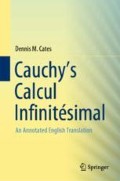Abstract
Let \(s=F(u, v, w, \dots )\) be any function of the variable quantities \( u, v, w, \dots \) that we suppose to be themselves functions of the independent variables \( x, y, z, \dots . \ \) s will be a composed function of these latter variables; and, if we designate by \( \varDelta x, \) \( \varDelta y, \) \( \varDelta z, \) \( \dots \) the arbitrary simultaneous increments attributed to \( x, y, z, \dots , \) the corresponding increments \( \varDelta u, \varDelta v, \varDelta w, \dots , \varDelta s \) of the functions \( u, v, w, \dots , s \) will be related among themselves by the formula
Moreover, let
be the partial derivatives of the function \(F(u, v, w, \dots )\) taken successively with respect to \( u, \) v, w, \( \dots . \ \)
Access this chapter
Tax calculation will be finalised at checkout
Purchases are for personal use only
Notes
- 1.
Having been seen several times already, Cauchy uses this word frequently to denote the value of one.
- 2.
Several relationships within this grouping have errors in both the original 1823 and the 1899 reprint editions which have all been corrected here. The 1899 edition includes \( d(u-dv)=du-dv, \ \) \(d\frac{v}{u}=\frac{u dv-v du}{u^2} \), and \(du^v=vu^{v-1} du+v^v {\varvec{l}}u dv+\cdots . \ \) The original 1823 edition contains the expression \( d\left( \frac{u}{v}\right) =\frac{u dv-v du}{u^2}.\)
- 3.
Equation (13) has been corrected. Both the 1823 and the 1899 editions read,
$$\begin{aligned} d\sqrt{a^2-x^2}=-\frac{x \, dx}{\sqrt{a^2-x^2}}, \quad \quad d\sqrt{a^2+x^2}=\frac{x \, dx}{\sqrt{a+x}}.\qquad {(13)} \end{aligned}$$
Author information
Authors and Affiliations
Corresponding author
Rights and permissions
Copyright information
© 2019 Springer Nature Switzerland AG
About this chapter
Cite this chapter
Cates, D.M. (2019). USE OF PARTIAL DERIVATIVES IN THE DIFFERENTIATION OF COMPOSED FUNCTIONS. DIFFERENTIALS OF IMPLICIT FUNCTIONS.. In: Cauchy's Calcul Infinitésimal. Springer, Cham. https://doi.org/10.1007/978-3-030-11036-9_9
Download citation
DOI: https://doi.org/10.1007/978-3-030-11036-9_9
Published:
Publisher Name: Springer, Cham
Print ISBN: 978-3-030-11035-2
Online ISBN: 978-3-030-11036-9
eBook Packages: Mathematics and StatisticsMathematics and Statistics (R0)

